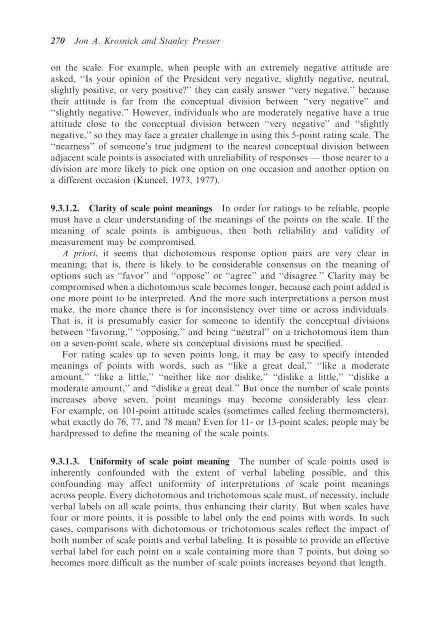Question and Questionnaire Design - Stanford University
Question and Questionnaire Design - Stanford University
Question and Questionnaire Design - Stanford University
Create successful ePaper yourself
Turn your PDF publications into a flip-book with our unique Google optimized e-Paper software.
270 Jon A. Krosnick <strong>and</strong> Stanley Presseron the scale. For example, when people with an extremely negative attitude areasked, ‘‘Is your opinion of the President very negative, slightly negative, neutral,slightly positive, or very positive?’’ they can easily answer ‘‘very negative,’’ becausetheir attitude is far from the conceptual division between ‘‘very negative’’ <strong>and</strong>‘‘slightly negative.’’ However, individuals who are moderately negative have a trueattitude close to the conceptual division between ‘‘very negative’’ <strong>and</strong> ‘‘slightlynegative,’’ so they may face a greater challenge in using this 5-point rating scale. The‘‘nearness’’ of someone’s true judgment to the nearest conceptual division betweenadjacent scale points is associated with unreliability of responses — those nearer to adivision are more likely to pick one option on one occasion <strong>and</strong> another option ona different occasion (Kuncel, 1973, 1977).9.3.1.2. Clarity of scale point meanings In order for ratings to be reliable, peoplemust have a clear underst<strong>and</strong>ing of the meanings of the points on the scale. If themeaning of scale points is ambiguous, then both reliability <strong>and</strong> validity ofmeasurement may be compromised.A priori, it seems that dichotomous response option pairs are very clear inmeaning; that is, there is likely to be considerable consensus on the meaning ofoptions such as ‘‘favor’’ <strong>and</strong> ‘‘oppose’’ or ‘‘agree’’ <strong>and</strong> ‘‘disagree.’’ Clarity may becompromised when a dichotomous scale becomes longer, because each point added isone more point to be interpreted. And the more such interpretations a person mustmake, the more chance there is for inconsistency over time or across individuals.That is, it is presumably easier for someone to identify the conceptual divisionsbetween ‘‘favoring,’’ ‘‘opposing,’’ <strong>and</strong> being ‘‘neutral’’ on a trichotomous item thanon a seven-point scale, where six conceptual divisions must be specified.For rating scales up to seven points long, it may be easy to specify intendedmeanings of points with words, such as ‘‘like a great deal,’’ ‘‘like a moderateamount,’’ ‘‘like a little,’’ ‘‘neither like nor dislike,’’ ‘‘dislike a little,’’ ‘‘dislike amoderate amount,’’ <strong>and</strong> ‘‘dislike a great deal.’’ But once the number of scale pointsincreases above seven, point meanings may become considerably less clear.For example, on 101-point attitude scales (sometimes called feeling thermometers),what exactly do 76, 77, <strong>and</strong> 78 mean? Even for 11- or 13-point scales, people may behardpressed to define the meaning of the scale points.9.3.1.3. Uniformity of scale point meaning The number of scale points used isinherently confounded with the extent of verbal labeling possible, <strong>and</strong> thisconfounding may affect uniformity of interpretations of scale point meaningsacross people. Every dichotomous <strong>and</strong> trichotomous scale must, of necessity, includeverbal labels on all scale points, thus enhancing their clarity. But when scales havefour or more points, it is possible to label only the end points with words. In suchcases, comparisons with dichotomous or trichotomous scales reflect the impact ofboth number of scale points <strong>and</strong> verbal labeling. It is possible to provide an effectiveverbal label for each point on a scale containing more than 7 points, but doing sobecomes more difficult as the number of scale points increases beyond that length.
















